Category: AWS Marketplace
AWS Marketplace Update – SaaS Contracts in Action
AWS Marketplace lets AWS customers find and use products and services offered by members of the AWS Partner Network (APN). Some marketplace offerings are billed on an hourly basis, many with a cost-saving annual option designed to line up with the procurement cycles of our enterprise customers. Other offerings are available in SaaS (Software as a Service) form and are billed based on consumption units specified by the seller. The SaaS model (described in New – SaaS subscriptions on AWS Marketplace) give sellers the flexibility to bill for actual usage: number of active hosts, number of requests, GB of log files processed, and so forth.
Recently we extended the SaaS model with the addition of SaaS contracts, which my colleague Brad Lyman introduced in his post, Announcing SaaS Contracts, a Feature to Simplify SaaS Procurement on AWS Marketplace. The contracts give our customers the opportunity save money by setting up monthly subscriptions that can be expanded to cover a one, two, or three year contract term, with automatic, configurable renewals. Sellers can provide services that require up-front payment or that offer discounts in exchange for a usage commitment.
Since Brad has already covered the seller side of this powerful and flexible new model, I would like to show you what it is like to purchase a SaaS contract. Let’s say that I want to use Splunk Cloud. I simply search for it as usual:
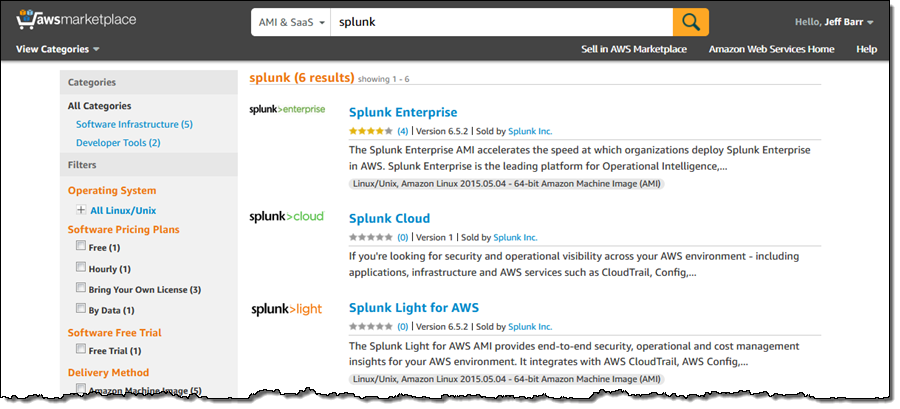 I click on Splunk Cloud and see that it is available in SaaS Contract form:
I click on Splunk Cloud and see that it is available in SaaS Contract form:
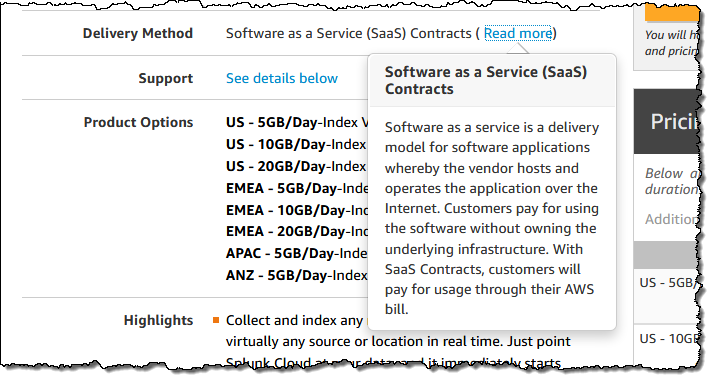 I can also see and review the pricing options, noting that pricing varies by location, index volume, and subscription duration:
I can also see and review the pricing options, noting that pricing varies by location, index volume, and subscription duration:

I click on Continue. Since I do not have a contract with Splunk for this software, I’ll be redirected to the vendor’s site to create one as part of the process. I choose my location, index volume, and contract duration, and opt for automatic renewal, and then click on Create Contract:
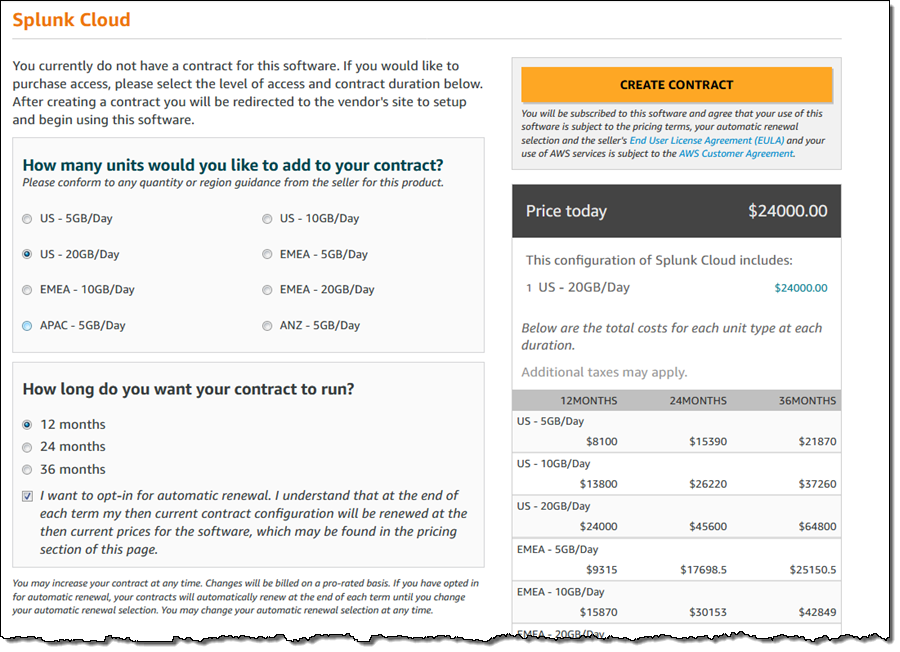
This sets up my subscription, and I need only set up my account with Splunk:
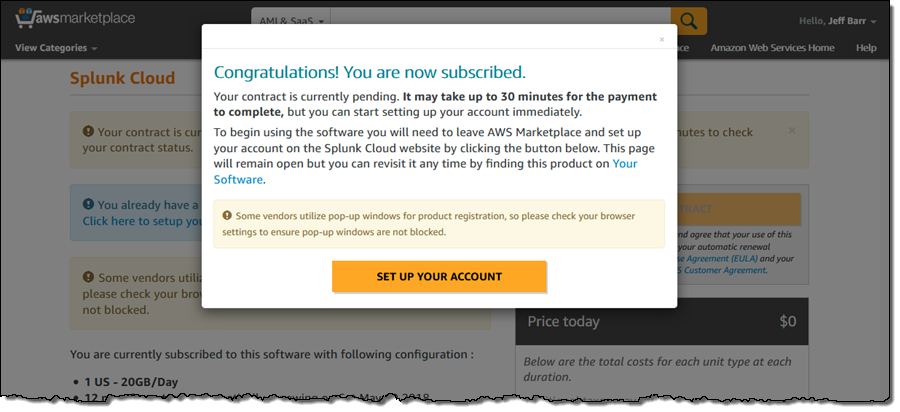
I click on Set Up Your Account and I am ready to move forward by setting up my custom URL on the Splunk site:
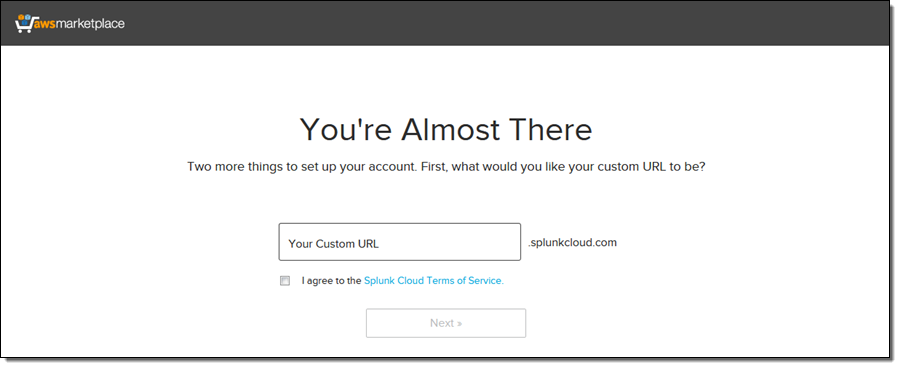
This feature is available now and you can start using it today.
— Jeff;
Box Platform on AWS Marketplace – Lambda Blueprints & Sample Code
Box is a cloud-based file sharing and content management system, with an API that recently became available in AWS Marketplace (Box Platform – Cloud Content Management APIs). With an array of features for collaboration and an emphasis on security, Box has found a home in many enterprises (see their success stories page for a list).
The Box API allows developers to build content experiences into web and mobile apps. Today I would like to tell you about some AWS Lambda blueprints and templates that will help you to build AWS applications that use this API to simplify user authentication and to add metadata to newly uploaded content. The templates are based on the Box Node Lambda Sample and should be a robust starting point for your own development.
Let’s take a look at the blueprints and then review some handy blog posts written by our friends at Box.
Box Blueprints for Lambda
The blueprints show you how to call the Box APIS and to connect a Box webhook to a Lambda function via Amazon API Gateway. To find them, simply open up the Lambda Console and search for box:
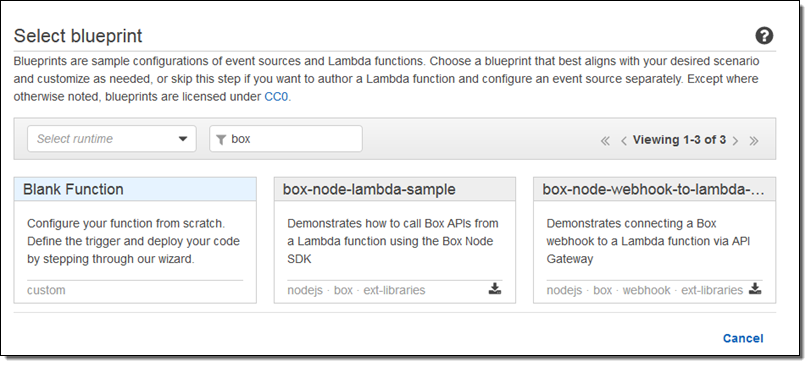
The first blueprint uses security credentials stored in the BOX_CONFIG environment variable. You can set the variable from within the Lambda Console:
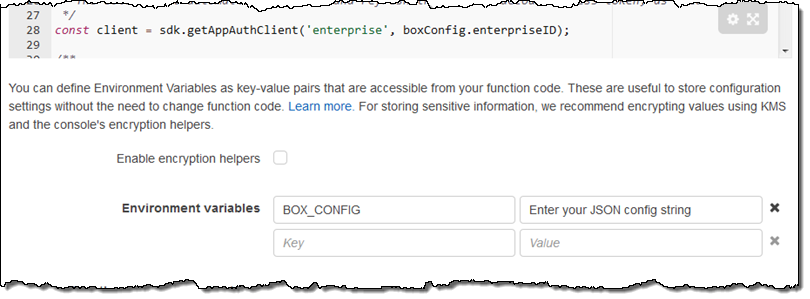
The code in this blueprint retrieves and logs the Box User object for the user identified by the credentials.
The second blueprint implements a Box webhook that sits behind an API Gateway endpoint. It accepts requests, validates them, and logs them to Amazon CloudWatch:
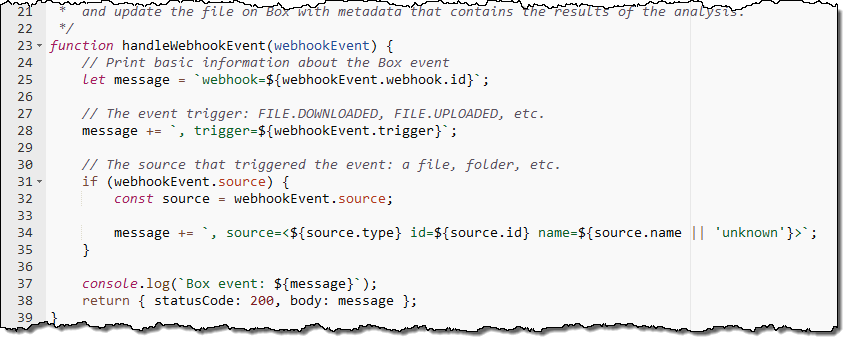
Handy Blog Posts
The developer relations team at Box has written some blog posts that show you how to use Box in conjunction with several AWS services:
Manage User Authentication with Box Platform using Amazon Cognito – This post shows you how to use Amazon Cognito to power a login page for your app users. Cognito will handle authentication and user pool management and the code outlined in the blog post will create an App User in Box the first time the user logs in. The code is available as box-node-cognito-lambdas-sample on GitHub.
Add Deep Learning-based Image Recognition to your Box App with Amazon Rekognition – This post shows you how to build an image tagging application that is powered by Amazon Rekognition. Users take and upload photos, which are automatically labeled with metadata that that is stored in Amazon DynamoDB. The code is activated by a webhook when a file is uploaded. You can find the code in the box-node-rekognition-webhook on GitHub.
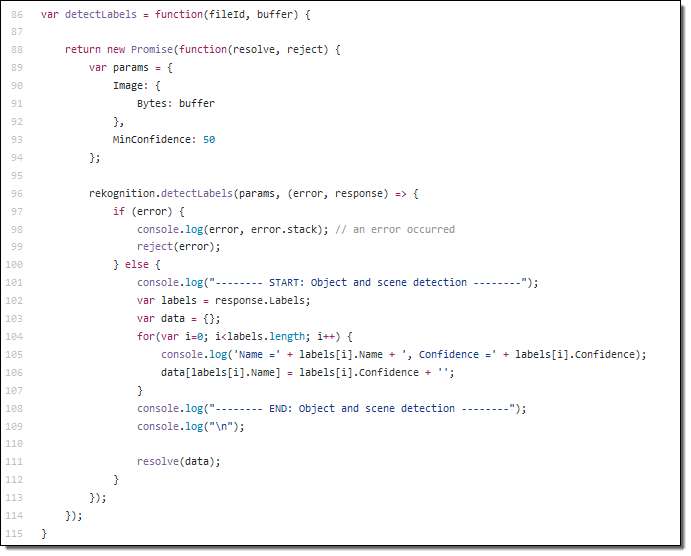 Thanks to our friends at Box for taking the time to create these helpful developer resources!
Thanks to our friends at Box for taking the time to create these helpful developer resources!
— Jeff;
Announcing 5 Partners That Have Achieved AWS Service Partner Status for AWS Service Catalog
Allison Johnson from the AWS Marketplace wrote the guest post below to share some important APN news.
-Ana
At last November’s re:Invent, we announced the AWS Service Delivery Program to help AWS customers find partners in the AWS Partner Network (APN) with expertise in specific AWS services and skills. Today we are adding Management Tools as a new Partner Solution to the Service Delivery program, and AWS Service Catalog is the first product to launch in that category. APN Service Catalog partners help create catalogs of IT services that are approved by the customer’s organization for use on AWS. With AWS Service Catalog, customers and APN partners can centrally manage commonly deployed IT services to help achieve consistent governance and meet compliance requirements while enabling users to self-provision approved services.
We have an enormous APN partner ecosystem, with thousands of consulting partners, and this program simplifies the process of finding partners experienced in implementing Service Catalog. The consulting partners we are launching this program with today are BizCloud Experts, Cloudticity, Flux7, Logicworks, and Wipro.

The process our partners go through to achieve the Service Catalog designation is not easy. All of the partners must have publicly referenceable customers using Service Catalog, and there is a technical review to ensure that they understand Service Catalog almost as well as our own Solution Architects do!
One common theme from all of the partner’s technical applications was the requirement to help their customers meet HIPAA compliance objectives. HIPAA requires three essential components: 1) establishment of processes, 2) enforcement of processes, and 3) separation of roles. Service Catalog helps with all three. Using AWS CloudFormation templates, Service Catalog Launch constraints, and identity and access management (IAM) based permission to Service Catalog portfolios, partners are able to establish and strictly enforce a process for infrastructure delivery for their customers. Separation of roles is achieved by using Service Catalog’s launch constraints and IAM, and our partners were able to create separation of roles such that developers were agile but were only allowed to do what their policies permitted them to.
Another common theme was the use of Service Catalog for self-service discovery and launch of AWS services. Customers can navigate to the Service Catalog to view the dashboard of products available to them, and they are empowered to launch their own resources.
Customers also use Service Catalog for standardization and central management. The customer’s service catalog manager can manage resource updates and changes via the Service Catalog dashboard. Tags can be standardized across instances launched from the Service Catalog.
Below are visual diagrams of Service Catalog workflows created for two of BizCloud Expert’s customers.


Ready to learn more? If you are an AWS customer looking for a consulting partner with Service Catalog expertise, click here for more information about our launch partners. If you are a consulting partner and would like to apply for membership, contact us.
-Allison Johnson
AWS and Healthcare: View From the Floor of HIMSS17
Jordin Green is our guest writer today, with an inside view from the floor of HIMSS17.
-Ana
 Empathy. It’s not always a word you hear associated with technology but one might argue it should be a central tenet for the application of technology in healthcare, and I was reminded of that fact as I wandered the halls representing AWS at HIMSS17, the Healthcare Information and Management System Society annual meeting.
Empathy. It’s not always a word you hear associated with technology but one might argue it should be a central tenet for the application of technology in healthcare, and I was reminded of that fact as I wandered the halls representing AWS at HIMSS17, the Healthcare Information and Management System Society annual meeting.
At Amazon, we’re taught to obsess over our customers, but this obsession takes on a new level of responsibility when those customers are directly working on improving the lives of patients and the overall wellness of society. Thinking about the challenges that healthcare professionals are dealing with every day drives home how important it is for AWS to ensure that using the cloud in healthcare is as frictionless as possible. So with that in mind I wanted to share some of the things I saw in and around HIMSS17 regarding healthcare and AWS.
I started my week at the HIMSS Cloud Computing Forum, which was a new full-day HIMSS pre-day focused on educating the healthcare community on cloud. I was particularly struck by the breadth of cloud use cases being explored throughout the industry, even compared to a few years ago. The program featured presentations on cloud-based care coordination, precision medicine, and security. Perhaps one of the most interesting presentations came from Jessica Kahn from the Center for Medicare & Medicaid Services (CMS), talking about the analytics platform that CMS has built in the cloud along with Nuna. Jessica talked about how a cloud-based platform allows CMS to make decisions based on data that is a month old, rather than a year or years old. Additionally, using an automated, rules-based approach, policymakers can directly query the data without having to rely on developers, bringing agility. Nuna has already gained a number of insights from hosting this de-identified Medicaid data for policy research, and is now looking to expand its services to private insurance.
The exhibition opened on Monday, and I was really excited to talk to customers about the new Healthcare & Life Sciences category in the AWS Marketplace. AWS Marketplace is a managed and curated software catalog that helps customers innovate faster and reduce costs, by making it easy to discover, evaluate, procure, immediately deploy and manage 3rd party software solutions. When a customer purchases software via the Marketplace, all of the infrastructure needed to run on AWS is deployed automatically, using the same pay-as-you-go pricing model that AWS uses. Creation of a dedicated category of healthcare is a huge step forward in making it easier for our customers to deploy cloud-based solutions. Our new category features telehealth solutions, products for managing HIPAA compliance, and products that can be used for revenue cycle management from AWS Partner Network (APN) such as PokitDok. We’re just getting started with this category; look for new additions throughout the year.
Later in the week, I tried to spend time at the number of APN Partners exhibiting at HIMSS this year, and it’s safe to say our ecosystem also had lots of moments to shine. Orion Health announced that they will migrate their Amadeus precision medicine platform to the AWS Cloud. Orion has been deploying on top of AWS for a while now, including notably the California-wide Health Information Exchange CalINDEX. Amadeus currently manages 110 million patient records; the migration will represent a significant volume of clinical data running on AWS. New APN Partner Merck announced a new Alexa skill challenge, asking developers to come up with new, innovative ways to use Alexa in the management of chronic disease. Healthcare Competency Partner ClearDATA announced its new fully-managed Containers-as-a-Service product, which simplifies development of healthcare applications by providing developers with a HIPAA-compliant environment for building, testing, and deployment.
This is only a small sample of the activity going on at HIMSS this year, and it’s impossible to capture everything in one post. You learn more about healthcare on AWS on our Cloud Computing in Healthcare page. Nonetheless, after spending four days diving in to healthcare IT, it was great to see how AWS is enabling our healthcare customers and partners deliver solutions that are impacting millions of lives across the globe.
AWS Marketplace Adds Healthcare & Life Sciences Category
Wilson To and Luis Daniel Soto are our guest bloggers today, telling you about a new industry vertical category that is being added to the AWS Marketplace.Check it out!
-Ana
AWS Marketplace is a managed and curated software catalog that helps customers innovate faster and reduce costs, by making it easy to discover, evaluate, procure, immediately deploy and manage 3rd party software solutions. To continue supporting our customers, we’re now adding a new industry vertical category: Healthcare & Life Sciences.

This new category brings together best-of-breed software tools and solutions from our growing vendor ecosystem that have been adapted to, or built from the ground up, to serve the healthcare and life sciences industry.
Healthcare
Within the AWS Marketplace HCLS category, you can find solutions for Clinical information systems, population health and analytics, health administration and compliance services. Some offerings include:
- Allgress GetCompliant HIPAA Edition – Reduce the cost of compliance management and adherence by providing compliance professionals improved efficiency by automating the management of their compliance processes around HIPAA.
- ZH Healthcare BlueEHS – Deploy a customizable, ONC-certified EHR that empowers doctors to define their clinical workflows and treatment plans to enhance patient outcomes.
- Dicom Systems DCMSYS CloudVNA – DCMSYS Vendor Neutral Archive offers a cost-effective means of consolidating disparate imaging systems into a single repository, while providing enterprise-wide access and archiving of all medical images and other medical records.
Life Sciences
- National Instruments LabVIEW – Graphical system design software that provides scientists and engineers with the tools needed to create and deploy measurement and control systems through simple yet powerful networks.
- NCBI Blast – Analysis tools and datasets that allow users to perform flexible sequence similarity searches.
- Acellera AceCloud – Innovative tools and technologies for the study of biophysical phenomena. Acellera leverages the power of AWS Cloud to enable molecular dynamics simulations.
Healthcare and life sciences companies deal with huge amounts of data, and many of their data sets are some of the most complex in the world. From physicians and nurses to researchers and analysts, these users are typically hampered by their current systems. Their legacy software cannot let them efficiently store or effectively make use of the immense amounts of data they work with. And protracted and complex software purchasing cycles keep them from innovating at speed to stay ahead of market and industry trends. Data analytics and business intelligence solutions in AWS Marketplace offer specialized support for these industries, including:
- Tableau Server – Enable teams to visualize across costs, needs, and outcomes at once to make the most of resources. The solution helps hospitals identify the impact of evidence-based medicine, wellness programs, and patient engagement.
- TIBCO Spotfire and JasperSoft. TIBCO provides technical teams powerful data visualization, data analytics, and predictive analytics for Amazon Redshift, Amazon RDS, and popular database sources via AWS Marketplace.
- Qlik Sense Enterprise. Qlik enables healthcare organizations to explore clinical, financial and operational data through visual analytics to discover insights which lead to improvements in care, reduced costs and delivering higher value to patients.
With more than 5,000 listings across more than 35 categories, AWS Marketplace simplifies software licensing and procurement by enabling customers to accept user agreements, choose pricing options, and automate the deployment of software and associated AWS resources with just a few clicks. AWS Marketplace also simplifies billing for customers by delivering a single invoice detailing business software and AWS resource usage on a monthly basis.
With AWS Marketplace, we can help drive operational efficiencies and reduce costs in these ways:
- Easily bring in new solutions to solve increasingly complex issues, gain quick insight into the huge amounts of data users handle.
- Healthcare data will be more actionable. We offer pay-as-you-go solutions that make it considerably easier and more cost-effective to ingest, store, analyze, and disseminate data.
- Deploy healthcare and life sciences software with 1-Click ease — then evaluate and deploy it in minutes. Users can now speed up their historically slow cycles in software procurement and implementation.
- Pay only for what’s consumed — and manage software costs on your AWS bill.
- In addition to the already secure AWS Cloud, AWS Marketplace offers industry-leading solutions to help you secure operating systems, platforms, applications and data that can integrate with existing controls in your AWS Cloud and hybrid environment.
Click here to see who the current list of vendors are in our new Healthcare & Life Sciences category.
Come on In
If you are a healthcare ISV and would like to list and sell your products on AWS, visit our Sell in AWS Marketplace page.
– Wilson To and Luis Daniel Soto
Introducing Allgress Regulatory Product Mapping
This guest post is brought to you by Benjamin Andrew and Tim Sandage.
-Ana
It’s increasingly difficult for organizations within regulated industries (such as government, financial, and healthcare) to demonstrate compliance with security requirements. The burden to comply is compounded by the use of legacy security frameworks and a lack of understanding of which services enable appropriate threat mitigations. It is further complicated by security responsibilities in relation to cloud computing, Internet of Things (IoT), and mobile applications.
Allgress helps minimize this burden by helping enterprise security and risk professionals assess, understand, and manage corporate risk. Allgress and AWS are working to offer a way to establish clear mappings from AWS services and 3rd party software solutions in AWS Marketplace to common security frameworks. The result for regulated customers within the AWS Cloud will be minimized business impact, increased security effectiveness, and reduced risk.
The name of this new solution is Allgress Marketplace Regulatory Product Mapping Tool (RPM). Allgress designed this tool specifically for customers deployed within AWS who want to reduce the complexity, increase the speed, and shorten the time frame of achieving compliance, including compliance with legislation such as Sarbanes Oxley, HIPAA, and FISMA. Allgress RPM is designed to achieve these results by letting customers quickly map their regulatory security frameworks (such as ISO, NIST, and PCI-DSS controls) to AWS services, solutions in AWS Markeplace, and APN technology partner solutions. The tool even guides customers through the compliance process, providing focused content every step of the way.
Here are the four simple steps to get a regulatory assessment:
- If you’re a new user, you can Login as a guest into the tool. Registration is not required. If you’re an existing user, you can log in using your Username and Password to return to a saved assessment:
![01[1]](https://d2908q01vomqb2.cloudfront.net/da4b9237bacccdf19c0760cab7aec4a8359010b0/2017/02/11/011-1024x491.png)
- Once you’ve logged in, you can select your Regulatory Security Framework (e.g. FedRAMP or PCI). After you’ve selected your framework, you have two explorer options: Coverage Overview and Product Explorer (explained in detail below).
![02[1]](https://d2908q01vomqb2.cloudfront.net/da4b9237bacccdf19c0760cab7aec4a8359010b0/2017/02/11/021-1024x505.png)
The Coverage Overview includes three use cases: AWS customer controls review, regulatory requirement mapping, and gap-assessment planning. The Product Explorer tool provides detailed control coverage for the AWS services selected and/or all available AWS Marketplace vendor solutions.
- You can select Coverage Overview to review AWS Inherited, Shared, Operation, and AWS Marketplace Control mappings.
![03[1]](https://d2908q01vomqb2.cloudfront.net/da4b9237bacccdf19c0760cab7aec4a8359010b0/2017/02/11/031.png)
Coverage overview – This view breaks down security frameworks into four categories:
- AWS Inherited Controls — Controls that you fully inherit from AWS.
- AWS Shared Controls — AWS provides the control implementation for the infrastructure, and you provide your own control implementation within its use of AWS services. (e.g. Fault Tolerance)
- Operational Controls – These are procedural controls that AWS or an AWS consulting partner can help you implement within your AWS environment.
- AWS Marketplace Controls — These are technical controls that can be implemented (partially or fully) with an AWS technology partner and vendors from AWS Marketplace.
Note: Features in this tool include the ability to zoom into the controls using your mouse. With point-and-click ease, you can zoom in at the domain (Control Family) level, or into individual controls:
![04[1]](https://d2908q01vomqb2.cloudfront.net/da4b9237bacccdf19c0760cab7aec4a8359010b0/2017/02/11/041.png)
![05[1]](https://d2908q01vomqb2.cloudfront.net/da4b9237bacccdf19c0760cab7aec4a8359010b0/2017/02/11/051.png)
- The additional capabilities within RPM is Product Explorer, which Identifies solutions in AWS Marketplace that can partially or fully implement the requirements of a security control. The screen below illustrates the 327 control for FedRAMP moderate — as well as several solutions available from software vendors on AWS Marketplace that can help remediate the control requirements.
![06[1]](https://d2908q01vomqb2.cloudfront.net/da4b9237bacccdf19c0760cab7aec4a8359010b0/2017/02/13/061-1024x589.png)
The Product Explorer page has several capabilities to highlight both service and control association:
- At the top of the page you can remove controls that do not currently have associated mapping.
- You can also zoom into Domains, Sub-domains, and Controls.
- You can select single products or multiple products with quick view options.
- You can select single or multiple products, and then select Product Cart to review detailed control implementations.
![07_CORRECT[1]](https://d2908q01vomqb2.cloudfront.net/da4b9237bacccdf19c0760cab7aec4a8359010b0/2017/02/13/07_CORRECT1-808x1024.png)
Product Explorer — Note: Non-associated controls have been removed in order to clearly see potential product mappings.
![08[1]](https://d2908q01vomqb2.cloudfront.net/da4b9237bacccdf19c0760cab7aec4a8359010b0/2017/02/13/081-1024x823.png)
Product Explorer — Zoom function for a specific control (e.g. AU-11) identifies all potential AWS services and associated products which can be leveraged for control implementation.
![09[1]](https://d2908q01vomqb2.cloudfront.net/da4b9237bacccdf19c0760cab7aec4a8359010b0/2017/02/13/091-1024x638.png)
Product Explorer – Single product control coverage view. For a detail view you can Click on the Product Cart and view detailed implementation notes.
![10[1]](https://d2908q01vomqb2.cloudfront.net/da4b9237bacccdf19c0760cab7aec4a8359010b0/2017/02/13/101.png)
Product Explorer – You can also add multiple services and solutions into a product cart and then connect to Marketplace for each software vendor solution available through our public managed software catalog.
![11[1]](https://d2908q01vomqb2.cloudfront.net/da4b9237bacccdf19c0760cab7aec4a8359010b0/2017/02/13/111-1024x556.png)
More about Allgres RPM
The AWS Services, Consulting, and Technology vendors that Allgress RPM is designed to map, have all demonstrated technical proficiency as a security solution, and can treat security controls across multiple regulated industries. At launch, RPM includes 10 vendors who all have deep experience working with regulated customers to deliver mission-critical workloads and applications on AWS. You can reach Allgress here.
View more Security solutions in AWS Marketplace. Please note that many of the products available in AWS Marketplace offer free trials. You can request free credits here: AWS Marketplace – Get Infrastructure Credits.
We wish to thank our launch partners, who worked with AWS and the Allgress team to map their products and services: Allgress, Alert Logic, Barracuda, Trend Micro, Splunk, Palo Alto Networks, OKTA, CloudCheckr, Evident.io and CIS (Center for Internet Security).
We wish to thank our launch partners, who worked with AWS and the Allgress team to map their products and services: Allgress, Alert Logic, Barracuda, Trend Micro, Splunk, Palo Alto Networks, OKTA, CloudCheckr, Evident.io and CIS (Center for Internet Security).
-Benjamin Andrew and Tim Sandage.
User Network-to-Amazon VPC Connectivity for Applications Hosted on AWS
With so much going on at AWS, we often hear from readers asking for ways to help them make more informed decisions, or put together examples for their planning processes. Joining us today is Jim Carroll, a Sr. Category Leader with Amazon Marketplace to talk about AWS Networking services and solutions in the AWS Marketplace.
-Ana
Last month we announced the new AWS Region in London. This new region expands our global infrastructure and provides our partners and customers with even more geographic options to cost-effectively scale and meet compliance and data residency requirements. This announcement is fresh in my mind because of conversations I’ve had recently with our customers about the AWS networking services and solutions in AWS Marketplace that they leverage to connect their corporate network to their virtual private network on the AWS Cloud.
Customers typically deploy this architecture with AWS in order to support one or a combination of business needs:
- Migrate applications to the AWS Cloud over time
- Quickly and cost-effectively scale their network for branch office and remote connectivity, improving end user experience while migrating applications to the AWS Cloud
- Ensure compliance and data residency requirements are met
Today, I will overview the VPN options available to customers with these business needs, to help simplify their decision-making. With Amazon VPC, you can configure an AWS managed VPN, use private circuit connectivity with AWS Direct Connect, and enable third-party networking software on your VPC for VPN connectivity. You may also choose a client-to-site VPN that allows users to directly access AWS from their desktop or mobile devices.
Steve Morad’s 2014 whitepaper, Amazon Virtual Private Cloud Connectivity Options, provides an overview of the remote network-to-Amazon VPC connectivity options. The table below summarizes these insights, followed by considerations for selecting an AWS managed VPN or a user-managed software VPN end-point in your virtual network on AWS. This discussion contains information from Morad’s whitepaper.
| User Network–to–Amazon VPC Connectivity Options | |
| AWS Managed VPN | IPsec VPN connection over the Internet |
| AWS Direct Connect | Dedicated network connection over private lines |
| AWS Direct Connect + VPN | IPsec VPN connection over private lines |
| AWS VPN CloudHub | Connect remote branch offices in a hub-and-spoke model for primary or backup connectivity |
| Software VPN | Software appliance-based VPN connection over the Internet |
AWS Managed VPN
This approach enables you to take advantage of an AWS-managed VPN endpoint that includes automated multi–data center redundancy and failover built into the AWS side of the VPN connection. Both dynamic and static routing options are provided to give you flexibility in your routing configuration. Figure 1 illustrates.
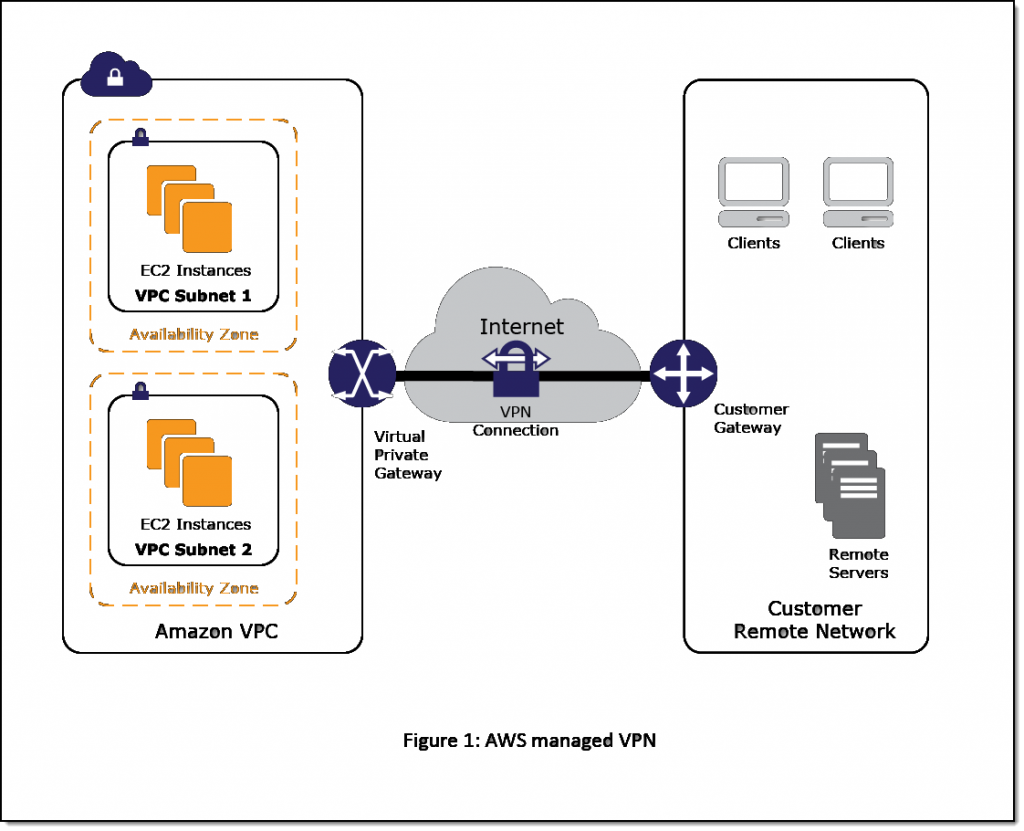
AWS managed VPN considerations:
- Although not shown, the Amazon virtual private gateway represents two distinct VPN endpoints, physically located in separate data centers to increase the availability of your VPN connection.
- Both dynamic and static routing options are provided to give you flexibility in your routing configuration.
- Dynamic routing leverages Border Gateway Protocol (BGP) peering to exchange routing information between AWS and these remote endpoints.
- With dynamic routing, you can also specify routing priorities, policies, and weights (metrics) in your BGP advertisements and influence the path between your network(s) and AWS.
- When using dynamic routing, routes advertised via BGP can be propagated into selected routing tables, making it easier to advertise new routes to AWS.
Software VPN
This option utilizes a software VPN appliance that runs on a single Amazon EC2 instance connecting to your remote network. This option requires that you manage both sides of your Amazon VPC connectivity, including managing the software appliance, configuration, patches, and upgrades.
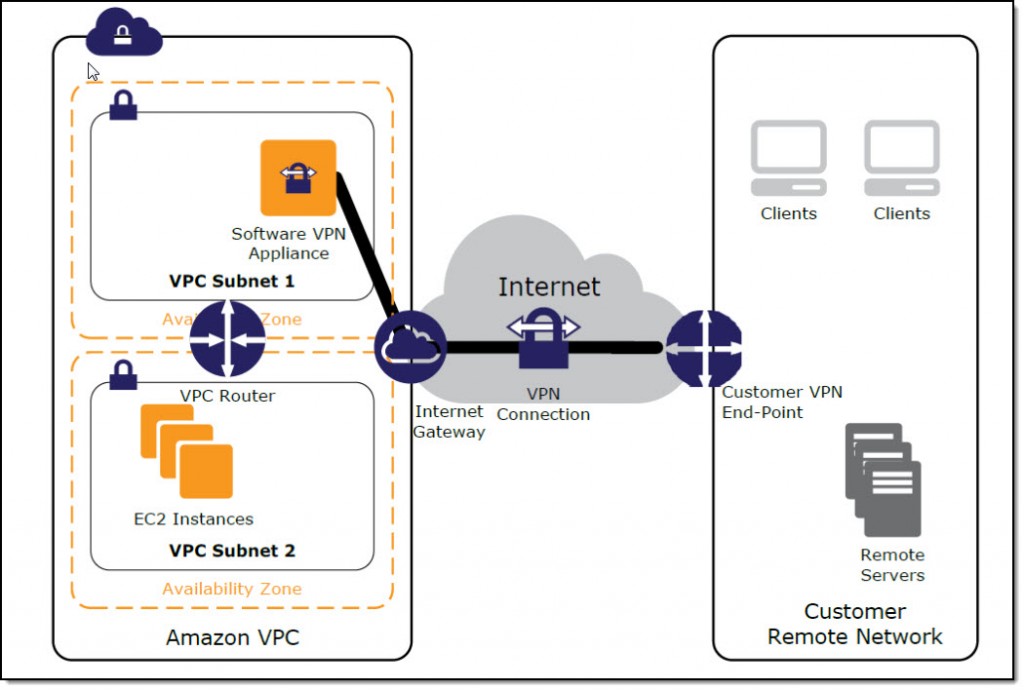
This option is recommended if you must manage both ends of the VPN connection. Considerations:
- Compliance: You may need to use this approach for compliance and data residency requirements in your hybrid network architecture. IT security and privacy regulations govern specific industries and require your IT infrastructure, including your network, to meet certain government standards.
- Gateway device support: Customers with gateway devices that are not currently supported by the Amazon managed VPN solution, choose to deploy a Software VPN in order to leverage existing on-premises investments. The list of supported gateway devices is located here.
- Networking infrastructure solutions in AWS Marketplace: You can easily extend your on-premises networking infrastructure software with pre-configured and customizable AMIs from popular software vendors on AWS Marketplace.
Example of HA Architecture for Software VPN Instances
Creating a fully resilient VPC connection for software VPN instances requires the setup and configuration of multiple VPN instances and a monitoring instance to track the health of the VPN connections.
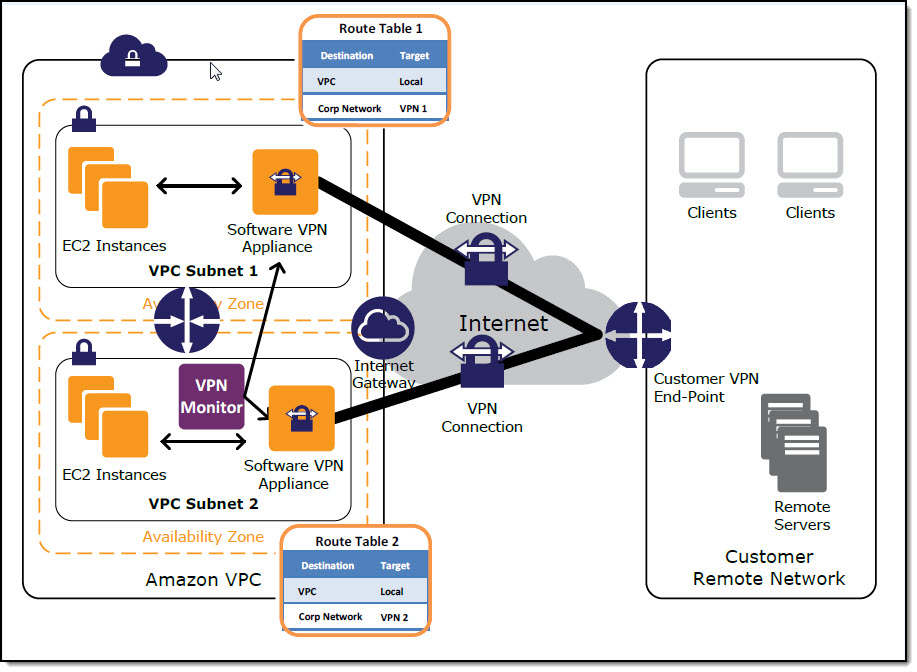
Figure 3: High-Level HA Design
We recommend configuring your VPC route tables to leverage all VPN instances simultaneously by directing traffic from all of the subnets in one Availability Zone through its respective VPN instances in the same Availability Zone. Each VPN instance will then provide VPN connectivity for instances that share the same Availability Zone. The white paper provides more information and considerations.
By leveraging networking infrastructure solutions from popular vendors such as Brocade and Cisco in AWS Marketplace, you can take full advantage of existing investments in on-premises systems and thecloud to meet your unique business challenges.
-Jim Carroll
From Raspberry Pi to Supercomputers to the Cloud: The Linux Operating System
Matthew Freeman and Luis Daniel Soto are back talking about the use of Linux through the AWS Marketplace.
– Ana
Linux is widely used in corporations now as the basis for everything from file servers to web servers to network security servers. The no-cost as well as commercial availability of distributions makes it an obvious choice in many scenarios. Distributions of Linux now power machines as small as the tiny Raspberry Pi to the largest supercomputers in the world. There is a wide variety of minimal and security hardened distributions, some of them designed for GPU workloads.
Even more compelling is the use of Linux in cloud-based infrastructures. Its comparatively lightweight architecture, flexibility, and options for customizing it make Linux ideal as a choice for permanent network infrastructures in the cloud, as well as specialized uses such as temporary high-performance server farms that handle computational loads for scientific research. As a demonstration of their own commitment to the Linux platform, AWS developed and continues to maintain their own version of Linux that is tightly coupled with AWS services.
AWS has been a partner to the Linux and Open Source Communities through AWS Marketplace:
- It is a managed software catalog that makes it easy for customers to discover, purchase, and deploy the software and services they need to build solutions and run their businesses.
- It simplifies software licensing and procurement by enabling customers to accept user agreements, choose pricing options, and automate the deployment of software and associated AWS resources with just a few clicks.
- It can be searched and filtered to help you select the Linux distribution – independently or in combination with other components – that best suits your business needs.
Selecting a Linux Distribution for Your Company
If you’re new to Linux, the dizzying array of distributions can be overwhelming. Deciding which distribution to use depends on a lot of different factors, and customers tell us that the following considerations are important to them:
- Existing investment in Linux, if any. Is this your first foray into Linux? If so, then you’re in a position to weight all options pretty equally.
- Existing platforms in use (such as on-premises networks). Are you adding a cloud infrastructure that must connect to your in-house network? If so, you need to consider which of the Linux distributions has the networking and application connectors you require.
- Intention to use more than one cloud platform. Are you already using another cloud provider? Will it need to interconnect with AWS? Your choice of Linux distribution may be affected by what’s available for those connections.
- Available applications, libraries, and components. Your choice of Linux distribution should take into consideration future requirements, and ongoing software and technical support.
- Specialized uses, such as scientific or technical requirements. Certain applications only run on specific, customized Linux distributions.
By examining your responses to each of these areas, you can narrow the list of possible Linux distributions to suit your business needs.
Linux in AWS Marketplace
AWS Marketplace is a great place to locate and begin using Linux distributions along with the top applications that run on them. You can deploy different versions of the distributions from this online store, and AWS scans the catalog daily for security, if we found an issue we notify you — this increases your speed. Scans are run continuously to identify vulnerabilities. AWS notifies customers of any issues found and works with experts to find work-arounds and updates. In addition to support provided by the sellers, the AWS Forums are a great place to ask questions about using Linux on AWS by setting up a free account on the forum. You can also get further details about Linux on AWS from the AWS Documentation.
Applications from AWS Marketplace Running on Linux
Here is a sampling of the featured Linux distributions and applications that run on them, which customers launch from AWS Marketplace.
CentOS Versions 7, 6.5, and 6
The CentOS Project is a community-driven, free software effort focused on delivering a robust open source ecosystem. CentOS is derived from the sources of Red Hat Enterprise Linux (RHEL), and it aims to be functionally compatible with RHEL. CentOS Linux is no-cost to use, and free to redistribute. For users, CentOS offers a consistent, manageable platform that suits a wide variety of deployments. For open source communities, it offers a solid, predictable base to build upon, along with extensive resources to build, test, release, and maintain their code. AWS has several CentOS AMIs that you can launch to take advantage of the stability and widespread use of this distribution.
Debian GNU Linux
Debian GNU/Linux, which includes the GNU OS tools and Linux kernel, is a popular and influential Linux distribution. Users have access to repositories containing thousands of software packages ready for installation and use. Debian is known for relatively strict adherence to the philosophies of Unix and free software as well as using collaborative software development and testing processes. It is popular as a web server operating system. Debian officially contains only free software, but non-free software can be downloaded from the Debian repositories and installed. Debian focuses on stability and security, and is used as a base for many other distributions. AWS has AMIs for Debian available for launch immediately.
Amazon Linux AMI
Amazon Linux is a supported and maintained Linux image provided by AWS. Amazon EC2 Container Service makes it easy to manage Docker containers at scale by providing a centralized service that includes programmatic access to the complete state of the containers and Amazon EC2 instances in the cluster, schedules containers in the proper location, and uses familiar Amazon EC2 features like security groups, Amazon EBS volumes, and IAM roles. Amazon ECS allows you to make containers a foundational building block for your applications by eliminating the need to run a cluster manager, and by providing programmatic access to the full state of your cluster.
Other popular distributions available in AWS Marketplace include Ubuntu, SUSE, Red Hat, Oracle Linux, Kali Linux and more.
Getting Started with Linux on AWS Marketplace
You can view a list hundreds of Linux offerings by simply selecting the Operating System category from the Shop All Categories link on the AWS Marketplace home screen.

From there you can select your preferred distribution and browse the available offerings:
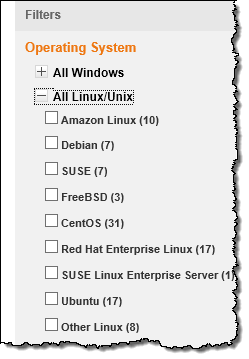
Most offerings include the ability to launch using 1-Click, so your Linux server can be up and running in minutes.
Flexibility with Pay-As-You-Go Pricing
You pay Amazon EC2 usage costs plus per hour (or per month or annual) and, if applicable, commercial Linux cost for certain distributions directly through your AWS account. You can see in advance what your costs will be, depending on the instance type you select. As a result, using AWS Marketplace is one of the fastest and easiest ways to launch your Linux solution.
Visit http://aws.amazon.com/mp/linux to learn more about Linux on AWS Marketplace.
Matthew Freeman and Luis Daniel Soto
Ready-to-Run Solutions: Open Source Software in AWS Marketplace
There are lot’s of exciting things going on in the AWS Marketplace. Here to tell you more about open source software in the marketplace are Matthew Freeman and Luis Daniel Soto.
– Ana
According to industry research, enterprise use of open source software (OSS) is on the rise. More and more corporate-based developers are asking to use available OSS libraries as part of ongoing development efforts at work. These individuals may be using OSS in their own projects (i.e. evenings and weekends), and naturally want to bring to work the tools and techniques that help them elsewhere.
Consequently, development organizations in all sectors are examining the case for using open source software for applications within their own IT infrastructures as well as in the software they sell. In this Overview, we’ll show you why obtaining your open source software through AWS makes sense from a development and fiscal perspective.
Open Source Development Process
Because open source software is generally developed in independent communities of participants, acquiring and managing software versions is usually done through online code repositories. With code coming from disparate sources, it can be challenging to get the code libraries and development tools to work well together. But AWS Marketplace lets you skip this process and directly launch EC2 instances with the OSS you want. AWS Marketplace also has distributions of Linux that you can use as the foundation for your OSS solution.
Preconfigured Stacks Give You an Advantage
While we may take this 1-Click launch ability for granted with commercial software, for OSS, having preconfigured AMIs is a huge advantage. AWS Marketplace gives software companies that produce combinations or “stacks” of the most popular open source software a location from which these stacks can be launched into the AWS cloud. Companies such as TurnKey and Bitnami use their OSS experts to configure and optimize these code stacks so that the software works well together. These companies stay current with new releases of the OSS, and update their stacks accordingly as soon as new versions are available. Some of these companies also offer cloud hosting infrastructures as a paid service to make it even easier to launch and manage cloud-based servers.
As an example, one of the most popular combinations of open source software is the LAMP stack, which consists of a Linux distribution, Apache Web Server, a MySQL database, and the PHP programming library. You can select a generic LAMP stack based on the Linux distribution you prefer, then install your favorite development tools and libraries.

You would then add to it any adjustments to the underlying software that you need or want to make for your application to run as expected. For example, you may want to change the memory allocations for the application, or change the maximum file upload size in the PHP settings.
You could select an OSS application stack that contains the LAMP elements plus a single application such as WordPress, Moodle, or Joomla!®. These stacks would be configured by the vendor with optimal settings for that individual application so that it runs smoothly, with sufficient memory and disk allocations based on the application requirements. This is where stack vendors excel in providing added value to the basic software provisioning.

You might instead choose a generic LAMP stack because you need to combine multiple applications on a single server that use common components. For example, WordPress has plugins that allow it to interoperate with Moodle directly. Both applications use Apache Web Server, PHP, and MySQL. You save time by starting with the LAMP stack, and configuring the components individually as needed for WordPress and Moodle to work well together.
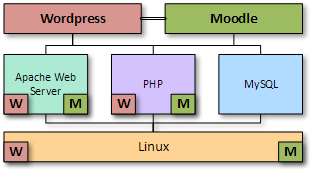
These are just 2 real-world examples of how you could use a preconfigured solution from AWS Marketplace and adapt it to your own needs.
OSS in AWS Marketplace
AWS Marketplace is one of the largest sites for obtaining and deploying OSS tools, applications, and servers. Here are some of the other categories in which OSS is available.
- Application Development and Test Tools. You can find on AWS Marketplace solutions and CloudFormation templates for EC2 servers configured with application frameworks such as Zend, ColdFusion, Ruby on Rails, and Node.js. You’ll also find popular OSS choices for development and testing tools, supporting agile software development with key product such as Jenkins for test automation, Bugzilla for issue tracking, Subversion for source code management and configuration management tools. Learn more »
- Infrastructure Software. The successful maintenance and protection of your network is critical to your business success. OSS libraries such as OpenLDAP and OpenVPN make it possible to launch a cloud infrastructure to accompany or entirely replace an on-premises network. From offerings dedicated to handling networking and security processing to security-hardened individual servers, AWS Marketplace has numerous security solutions available to assist you in meeting the security requirements for different workloads. Learn more »
- Database and Business Intelligence. Including OSS database, data management and open data catalog solutions. Business Intelligence and advanced analytics software can help you make sense of the data coming from transactional systems, sensors, cell phones, and a whole range of Internet-connected devices. Learn more »
- Business Software. Availability, agility, and flexibility are key to running business applications in the cloud. Companies of all sizes want to simplify infrastructure management, deploy more quickly, lower cost, and increase revenue. Business Software running on Linux provides these key metrics. Learn more »
- Operating Systems. AWS Marketplace has a wide variety of operating systems from FreeBSD, minimal and security hardened Linux installations to specialized distributions for security and scientific work. Learn more »
How to Get Started with OSS on AWS Marketplace
Begin by identifying the combination of software you want, and enter keywords in the Search box at the top of the AWS Marketplace home screen to find suitable offerings.
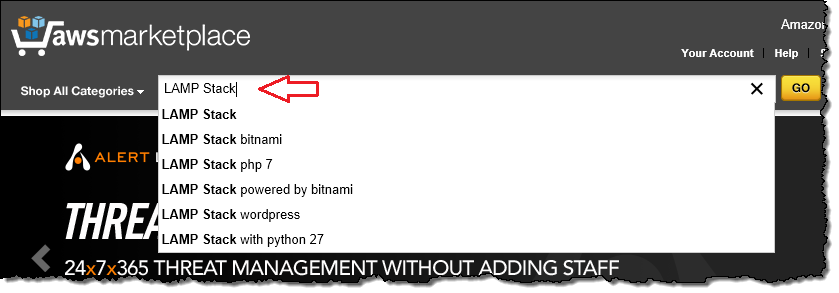
Or if you want to browse by category, just click “Shop All Categories” and select from the list.

Once you’ve made your initial search or selection, there are nearly a dozen ways to filter the results until the best candidates remain. For example, you can select your preferred Linux distribution by expanding the All Linux filter to help you find the solutions that run on that distribution. You can also filter for Free Trials, Software Pricing Plans, EC2 Instance Types, AWS Region, Average Rating, and so on.
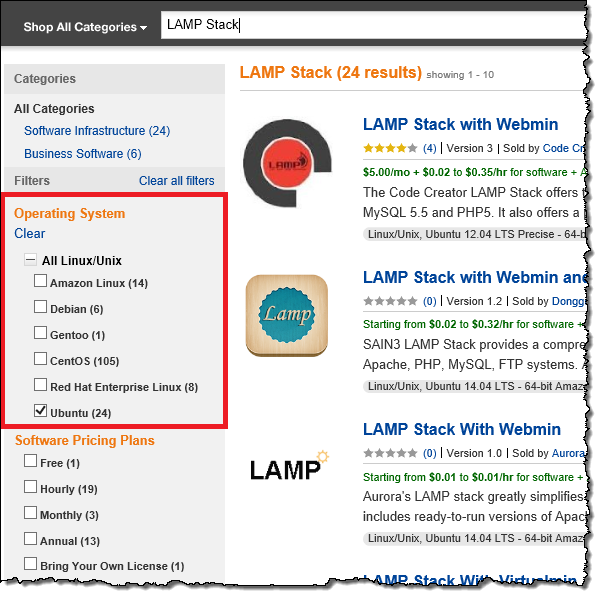
Click on the title of the listing to see the details of that offering, including pricing, regions, product support, and links to the seller’s website. When you’ve made your selections, and you’re ready to launch the instance, click Continue, and log into your account.
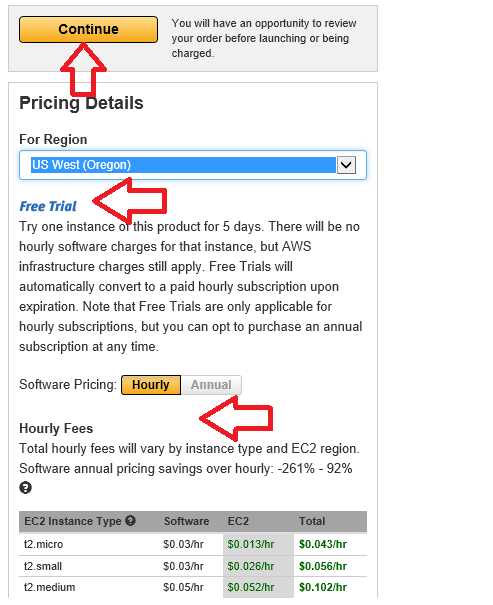
Because you log in, AWS Marketplace can detect the presence of existing security groups, key pairs, and VPC settings. Make adjustments on the Launch on EC2 page, then click Accept Software Terms & Launch with 1-Click, and your instance will launch immediately.

If you prefer you can do a Manual Launch using the AWS Console with the selection you’ve made, or start the instance using the API or command line interface (CLI). Either way, your EC2 instance is up and running within minutes.
Flexibility with Pay-As-You-Go Pricing
You pay Amazon EC2 usage costs plus per hour (or per month or annual) and, if applicable, commercial open source software fees directly through your AWS account. As a result, using AWS Marketplace is one of the fastest and easiest ways to get your OSS software up and running.
Visit http://aws.amazon.com/mp/oss to learn more about open source software on AWS Marketplace.
Matthew Freeman, Category Development Lead, AWS Marketplace
Luis Daniel Soto, Sr. Category GTM Leader, AWS Marketplace
New – SaaS Subscriptions on AWS Marketplace
You can now find, buy, and use a nice variety of SaaS (Software as a Service) solutions from AWS Marketplace Vendors.
The new SaaS solutions run on AWS infrastructure and you will pay only for the service that you consume, with no monthly fees or subscription costs. For example, you can buy security services on a per-host basis, log processing on a per-GB-ingested basis, geocoding on a per-request basis, or caching on a per-GB-cached basis. Usage charge for the services that you consume will appear on your AWS bill.
The list of vendors and products is growing every day; here’s what we have lined up so far:
| Application Development and Monitoring |
|
| Security and Log Management |
|
| Databases, BI, and Big Data |
|
| Media |
|
| Storage |
|
| Other Business Applications and Services |
|
The AWS Marketplace page for each of these offerings includes the relevant per-unit pricing information. Here are a couple of examples:
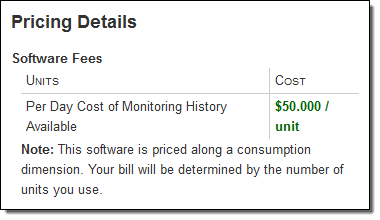

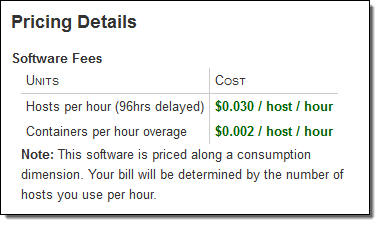
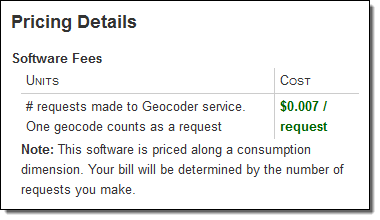
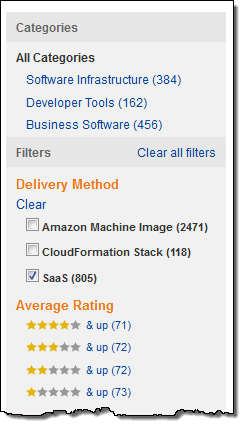
To learn more, visit the AWS Marketplace SaaS page.
Attention ISVs
If you are an ISV and would like to offer a new SaaS solution or modify an existing offering to become a SaaS solution, visit the Sell in AWS Marketplace page.
— Jeff;